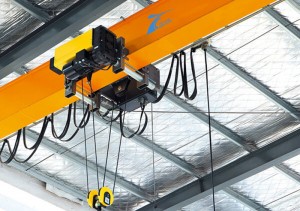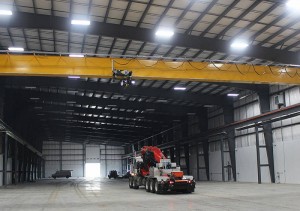
New Type Top Running Bridge Crane for Warehouse
What Is a Top Running Overhead Crane ?
A top running overhead crane operates on fixed crane rails mounted on the top of each runway beam. This design allows the end trucks or end carriages to support the main bridge girder and the lifting hoist as they travel smoothly along the top of the runway system. The elevated position not only provides excellent hook height but also allows for wider spans, making top running cranes a preferred choice for facilities requiring high lifting capacities and maximum coverage.
Top running cranes can be built in either single girder or double girder configurations. In a single girder design, the crane bridge is supported by one main beam and typically uses an underhung trolley and hoist. This configuration is cost-effective, lightweight, and ideal for light to medium duty applications. A double girder design incorporates two main beams and most often uses a top running trolley and hoist, allowing for higher capacities, greater hook height, and additional attachment options such as walkways or maintenance platforms.
Common Applications: Light manufacturing, fabrication and machine shops, assembly lines, warehouse operations, maintenance facilities, and repair workshops
♦Key Features
Top running single girder cranes are designed with a compact structure and low deadweight, making them easy to install and maintain. Their reduced material use compared to double girder designs leads to lower production costs and a more economical overall price. Despite their lightweight construction, they can still achieve impressive lifting performance. The design also allows for faster crane travel and hoisting speeds, increasing operational efficiency.
For businesses seeking a reliable, efficient, and cost-effective lifting solution, a top running single girder overhead crane offers the perfect balance between performance and affordability. Whether used in manufacturing plants, warehouses, or repair facilities, these cranes provide dependable service, ease of operation, and minimal maintenance requirements, making them a smart investment for long-term material handling needs.
Structural Design and Engineering
A top running bridge crane is engineered with the bridge mounted above the runway beams, allowing the entire crane to operate on top of the runway structure. This elevated design provides maximum support, stability, and hook height, making it ideal for heavy-duty lifting operations in industrial environments.
♦Structural Design
Bridge: The primary horizontal beam spanning between the runway beams, designed to carry the hoist and enable horizontal travel.
Hoist: The lifting mechanism that moves along the bridge, capable of handling heavy loads with precision.
End Trucks: Positioned at both ends of the bridge, these units allow the bridge to move smoothly along the runway beams.
Runway Beams: Heavy-duty beams mounted on independent columns or integrated into the building’s structure, supporting the entire crane system.
This design enhances load capacity and structural integrity, enabling safe and reliable performance in demanding applications.
♦Rail Placement and Support System
For top running bridge cranes, the rails are positioned directly on top of the runway beams. This placement not only allows for greater lifting capacity but also minimizes sway and deflection during operation. The support system is typically built from robust steel columns or integrated with the facility’s existing structural framework. In new installations, the runway system can be designed for maximum performance; in existing buildings, reinforcement may be required to meet load-bearing standards.
♦Load Capacity and Span
One of the major advantages of top running bridge cranes is their ability to handle very large loads and cover wide spans. Capacities can range from a few tons to several hundred tons, depending on the design. The span—distance between the runway beams—can be significantly longer than that of under running cranes, allowing for efficient material handling across large manufacturing floors, warehouses, and assembly areas.
♦Customization and Flexibility
Top running bridge cranes can be fully customized to match operational needs. This includes tailored span lengths, lifting capacities, lifting speeds, and even integration of specialized lifting devices. Options for automation and remote operation can also be incorporated to improve efficiency and safety.
Overall, the design of a top running bridge crane combines structural strength, operational efficiency, and adaptability. Its ability to lift heavy loads, cover large work areas, and maintain stability makes it an indispensable tool for industries such as steel manufacturing, shipbuilding, aerospace, heavy fabrication, and large-scale warehousing.




Maximizing Height and Capacity with Top Running Bridge Cranes
♦Top running bridge cranes stand out for their ability to handle heavy loads, making them an ideal choice for demanding lifting applications. Typically larger than underhung bridge cranes, they feature a robust structural design that allows for higher load capacities and wider spans between runway beams.
♦Mounting the trolley on top of the bridge offers maintenance benefits. Unlike underhung cranes, which may require trolley removal for access, top running cranes are easier to service. With proper walkways or platforms, most maintenance tasks can be carried out in place.
♦These cranes excel in environments with limited overhead clearance. Their elevation advantage is critical when maximum hook height is needed for lifting operations. Switching from an underhung to a top running crane can add 3 to 6 feet of hook height—an important benefit in facilities with low ceilings.
♦However, having the trolley positioned above can sometimes limit movement in certain spaces, especially where the roof slopes. This configuration may reduce coverage near ceiling-to-wall intersections, affecting maneuverability.
♦Top running bridge cranes are available in both single girder and double girder designs, with the choice depending mainly on the required lifting capacity. Carefully assessing the application’s needs is essential when deciding between the two.
















